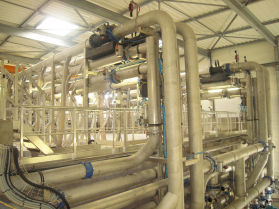special case of plants refurbishment
Reading time:Changes to regulations governing discharges and the increased number of users have resulted in the refurbishment of a large number of wastewater treatment plants.
These projects “upgrade plant capacity and performance in order to bring a plant into compliance with new standards” have significantly contributed to new technology design. In effect, if some systems allow us to re-use existing structures, for instance a lifting station that is capable of a higher throughput, settling tanks or biological tanks converted into storm water tanks or sludge storage tanks, most systems require the entire site to be redesigned for the following reasons:
- the capacities required, merely to improve treatment quality, are significantly higher than those that already exist;
- the state of existing structures (civil engineering and equipment) does not often provide for sufficient reliability and longevity. The cost of their renovation and of bringing them into compliance with new standards is often greater than rebuilding new structures that are appropriate to the new objectives;
- safety standards have undergone significant changes and bringing older plants into compliance requires major work;
- the problems raised by new plant construction will not necessarily be the same as those that existed when it was designed, urban development having often reached the plant’s site. Even when enough space has been set aside for extensions and if the process can be renewed, environmental limitations are frequently such that preference has to be given to other systems (more compact, etc.).
Therefore, many plant refurbishments are restricted to limited reconditioning, aimed at making it easier to phase construction pending total plant reconstruction.
However, it should be noted that the sludge treatment lines, more modular in nature, often mean that ancillary structures or systems can be re-used, assuming that their operating mode is still viable.
Finally, the original nature of some processes can easily adapt to the form and capacity of existing structures, allocating them to a task that is different from their original purpose.
As an example, the biological membrane treatment technique (Ultrafor process, see Ultrafor membrane bioreactor and clarification membrane applications) or, to a lesser extent, combined cultures (Meteor process) that can be used to increase capacity, or to carry out nitrification in a plant that had originally been designed to process carbon only while retaining the plant’s main structures.
Bookmark tool
Click on the bookmark tool, highlight the last read paragraph to continue your reading later













